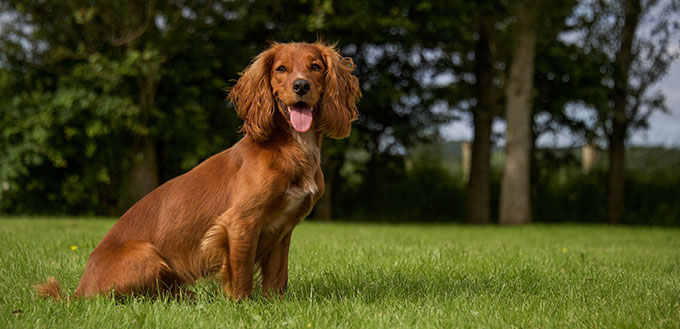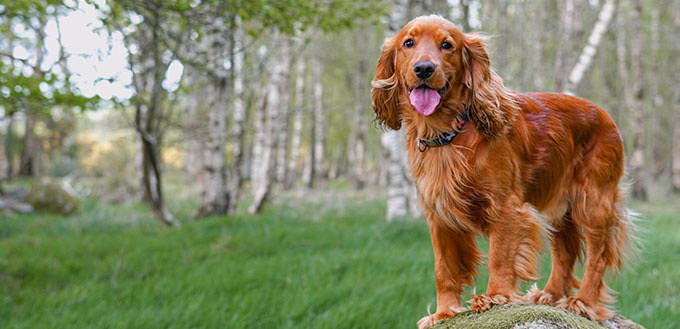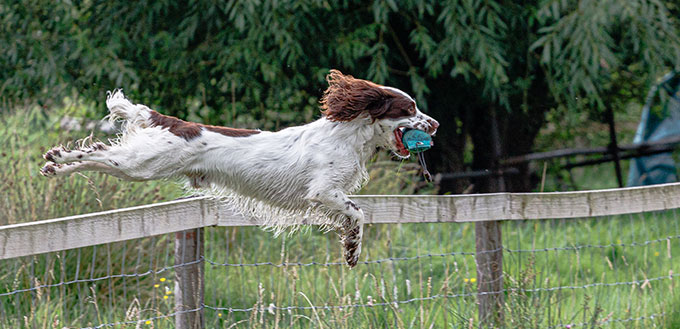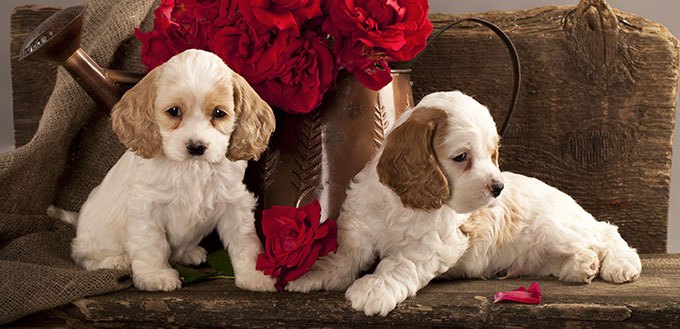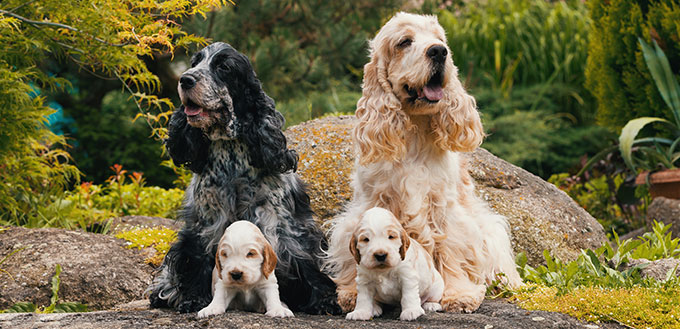A beautiful companion dog, the Cocker Spaniel has the movie star looks and affectionate temperament that makes the breed a joy to own. Epitomized by Disney in their movie, The Lady and the Tramp, this is a dog that’s aware of its own good looks yet is a gentle soul who seeks the love and attention of their human. Yes, they do take some grooming and can be a bit sensitive, but with the right care and socialization, they make wonderful family pets. We take an in-depth look at this gorgeous breed.
Breed Overview
Dog Breed Group: Sporting group
Height: Males: 15-17 inches; Females: 14-16 inches
Weight: Males: 28-34 pounds; Females: 26-32 pounds
Life Expectancy: 12 to 15 years
History of the Cocker Spaniel
One of the US’s most favorite dog breeds, the American Cocker Spaniel shares much of its history and characteristics with its counterpart, the English Cocker and both breeds are descended from the Spaniel family. Translated as the ‘Spanish dog’ it is believed the spaniel breed originated in Spain as hunting dogs. But by the 1800s, the breed was split into two types – the companion or toy spaniel and the working dog. And when it came to the working spaniel, they were also divided into two types – land and water hunting dogs, which is where the Cocker fits in. As efficient hunters, the Cocker Spaniel actually got its name from the game bird it was trained to hunt, the woodcock.
When it comes to the start of the American variety of the Cocker breed, this dates back to the 1870s, when the English Cocker Spaniel was imported to the United States. In fact, we know the first US-registered Cocker – a liver and white dog called Captain, who took the honor of being the first American Cocker Spaniel to be registered in the American Kennel Club’s very first studbook.
In 1881, the American Spaniel Club was formed, which is the oldest breed club in the US. By 1936, the English Cocker Spaniel Club was formed and slowly, the distinctions between the American and English Cocker Spaniel were recognized, with the slightly smaller companion-bred American Cocker Spaniel building a reputation for its appearance and flashy movements. These moves went on to bring the American Cocker Spaniel significant show ring success, with a cocker named My Own Brucie scooping Best American Bred in Show at the famous Westminster Dog Show in 1939 and then 1940.
The popularity of the American Cocker Spaniel soared, with breeders concentrating on producing dogs for the ring (as well as companions) rather than working sport dogs. It was in 1946 that the American and English Cocker Spaniel were finally recognized as two separate breeds by the American Kennel Club (AKC). The Cocker Spaniel’s popularity remains and is constantly in the top 30 most popular dog breeds in the US today.
Few More Words About Cocker Spaniel
Compared to other sport hunting dogs, as a game bird dog the Cocker is a relatively small pooch but has a large and super-friendly personality. He is easy to own due to his amiable approach to life, although he can tend to be a little clingy as loves the company of his human family and wants to be where the action is at. And his medium dog size makes him suitable for apartment living as well as in larger homes. All that obedience and devotion to his owner also makes him pretty easy to train, although his sensitive nature means he needs to be socialized from an early age so he can truly feel happy out of his ‘comfort zone’.
Loving, fun, playful and loyal, the Cocker also has a good life span and can live up to 15 or 16 years, making him an ideal family member to grow with young children. But due to his long silky coat, his grooming needs do make him a little high maintenance but nothing that can’t be managed with a regular and consistent routine.
To help you decide whether the gorgeous Cocker Spaniel is the right heart-dog for you, we dig a little deeper into the essential facts you need to know about this fabulous pup.
Cocker Spaniel Dog Breed Appearance
There’s no doubting that both the America and English Cocker Spaniel are beautiful dogs, displaying grace in their movements and an elegant body shape. The English Cocker Spaniel is slightly larger than its American Counterpart, but both breeds are considered medium size dogs.
The average male Cocker Spaniel weighs in at around 28-34 pounds and can stand up to 17 inches tall, while the female weighs 26-32 pounds and stands slightly smaller at up to 16 inches in size. The breed also has a distinctive broad-shaped head.
It is the coat of the Cocker that gives them their eye-catching appearance, coupled with luxuriantly feathered ears and tail and gorgeous ‘butter wouldn’t melt’ eyes. Their fur is thick and long, with a silky texture that crinkles into waves, particularly on their ears, legs and chest. The fur is shorter and softer on their head and back, making this an irresistibly strokable pooch!
When it comes to coat color varieties, there is a lovely variety with this breed, which can be seen in either solid or bi/tri-colored patterns. The main solid coat colors found in both the American and English Cocker Spaniel are black, red, orange, light cream and chocolate brown, while combinations include white and one or two colors, such as a white and black cocker spaniel or liver, lemon and chocolate as well as red, blue and orange roan.
Interesting Facts
- Cockers are the smallest sporting dog breed registered with the American Kennel Club
- They get their name from the birds they were bred to hunt, the woodcock
- They make excellent support dogs, with a Cocker Spaniel named Tangle being the world’s first cancer detecting dog, with an impressive 80% success rate
- Lady, from Disney’s 1955 Lady and the Tramp animation film was a Cocker Spaniel
- It’s thought that a Cocker Spaniel was aboard the Mayflower on its journey to America in 1620, along with a mastiff breed
- There are two recognized Cocker Spaniel breeds – the American and the English – with the American Cocker slightly smaller than its English cousin
- The waved sole on boat shoes was inspired by a Cocker Spaniel after inventor Paul Sperry watched his pet Cocker walk across ice without slipping
Cocker Spaniel Temperament
As a companion dog, there’s no denying the Cocker still has some of its hunting traits and so loves to play and be active. This means they can make wonderful pets where there are children in the household as they also love to be at the center of all the fun and family action. They are definitely a people canine!
Busy, friendly and happy – most Cockers are constantly wagging their tail – Cocker Spaniels are also known for their intelligence, which is why they make good agility and service dogs. But all that smartness needs to be channeled so regular play sessions, exercise and training will help to keep your bouncy Cocker under control.
When it comes to family life, Cocker Spaniels are good with children and other animals, although it is still recommended that children, especially little ones, play with their pet under supervision. And if you have a cat or two in the home, careful introduction and socialization is important for domestic harmony.
However, it is important to note that the Cocker is also considered a ‘sensitive’ dog and doesn’t respond to negativity or harsh treatment and can get nervous and even snap or growl if hurt, unsure or afraid. But you can support and reassure your Cocker with positive training and socialization from an early age. And treating your Cocker Spaniel with kindness and respect will always bring out the best in this cute and loving pet.
Both American and English Cocker Spaniel dogs are known to be vocal so early training in the ‘quiet’ command can help to keep the barking level down. And, as they were originally bred as a hunting dog, they still have those traits and can be prone to chasing birds, so good recall is essential, as is keeping your pooch on their leash when needed.
And finally, when it comes to highlighting the typical Cocker temperament, their affectionate nature must be at the top of the list. They simply love to be loved and will take no end of attention from their pet owners, which is only natural for these adorable cuddle monsters!
Cocker Spaniel Care
Being confident you can take care of your dog is essential for any new pet owner. Here are the care essentials you need to know about when it comes to looking after the Cocker Spaniel.
Health
Overall, the Cocker Spaniel breed is pretty healthy, but like most pure breeds they can be prone to certain health issues, including some genetic health conditions.
- Eye problems: Cockers can be particularly prone to problems with their eyes, including progressive retinal atrophy which is a degenerative disease that can lead to blindness. Cataracts and glaucoma are also seen in the breed as is the condition called ‘cherry eye’ which can be corrected through surgery. Cockers can be susceptible to dry eye too, in which they don’t produce enough tears to keep their eyes sufficiently lubricated and if not treated can eventually cause damage to their corneas.
- Dilated cardiomyopathy: English Cocker Spaniels are particularly prone to a heart condition called dilated cardiomyopathy, or DCM. This is a life-threatening condition which sees the heart become enlarged and weak, reducing its ability to pump blood around the body.
- Hip dysplasia: Affecting their mobility, this condition means their hips don’t fit into the sockets as they should and can lead to pain as well as lameness.
- Patellar luxation: This condition sees the kneecap dislocating and so falling out of place and causing pain and mobility issues.
- Autoimmune hemolytic anemia (AIHA): This involves the Cocker’s immune system, which attacks its own blood cells leading to acute anemia. Symptoms include pale gums and tiredness as well as jaundice. The liver can also be affected, leading to a swollen abdomen and potential liver disease. AIHA can be treated and managed although it can also prove fatal.
- Hypothyroidism: Affecting the thyroid gland, this condition sees underproduction of the thyroid hormone, leading to hair loss, canine obesity, shivering and skin conditions. Fortunately, hypothyroidism can be treated through diet and medication.
- Allergies: Both the American and English Cocker Spaniel can be prone to allergies, including allergic reactions to food as well as contact and inhalation allergies. Treatment depends on the nature of the allergy as well as avoidance of the irritant in question.
- Epilepsy: Canine epilepsy is often inherited and is a condition Cockers can be prone to. Symptoms include mild or severe seizures and can be also be caused by other conditions such as metabolic disorders so always get a full veterinarian check and diagnosis.
- Ear and hearing issues: Those stunning long, furry ears can actually cause health issues for your Cocker if not properly cared for. Long spaniel ears can be effective traps for dirt and moisture, which build up in the ear canal to cause irritation, yeast build up and potentially chronic ear infections. The merle gene – found in white Cockers with blue eyes – can also cause congenital deafness.
- Obesity: While the Cocker breed love to get out and play, they also love to be a couch potato as well as their food, meaning they can have a tendency to become overweight, particularly as they get older. A balanced and portion-controlled diet with daily exercise can help stave off excessive weight gain, and the associated health problems obesity can bring.
Training
Intelligent and eager to learn, the Cocker also has a soft and sensitive personality so using harsh training methods can leave them fearful and a little difficult to handle. They are also known to have a stubborn streak. To ensure your Cocker pup grows into a happy and well-trained pooch, always opt for gentle training methods and ensure it is consistent, so you get the very best results.
However, the beauty of the Cocker is that he really wants to please and so with the right reward-based approach, should be easy to train. They are active animals though, so you need to keep up with their training as well to ensure they get sufficient exercise to burn all that exuberant energy off. Potty training should be pretty easy though, as they just want to please their pack leader and if combined with positive reinforcement as well as rewards, training them to do their business outside should come quickly.
As they are a sporting dog at heart, Cocker Spaniels are well suited to agility type training and dog shows as they love a job to do, especially if their favorite people are involved in the fun and games! Also, you need to keep in mind their hunting traits when it comes to other pets and wildlife. This means establishing a solid recall at an early age as well as effective socialization with other pets, especially cats as well as dogs, so they can be calm and happy to mix when out on a walk.
Exercising
Lively and great fun, the Cocker Spaniel loves exercise, but they also love their home comforts too so don’t necessarily need a large yard or garden to roam. However, this fun-loving little dog does need daily exercise to keep fit and healthy as well as for mental stimulation. The ideal for most Cockers is space in the yard to mooch and play as well as a 30-minute walk once, ideally twice a day. It is also a good idea to shake up their play and exercise routine with toys and fetch games, so they feel they have a job to do – they have their hunting instincts and an inner prey drive to be positively directed. Lack of stimulation in their exercise and play can leave your Cocker feeling bored and under-stimulated and, as with most dogs, boredom can lead to unwanted behaviors, including barking and chewing, which you want to avoid.
Agility and obedience training works well too, and Cocker Spaniels are good at many dog sports, including hunt tests and competitive flyball. In short, there’s so much you can do with your gorgeous, happy and active Cocker Spaniel, there will be no time for either of you to get bored!
Feeding
With all that energy and playfulness, it’s no wonder the Cocker Spaniel has a healthy appetite and is known to over-eat given half a chance. This means that you need to be careful with the quantities of food you give your pet to ensure his weight is healthy as over-feeding can result in obesity and all the health issues it can bring.
Always choose a quality dog food containing quality protein and appropriate for his life stage, from puppy to adult dog and through to his senior years so he is getting the nutrition he needs to thrive.
The recommended daily amount of food for a dog the size of a Cocker Spaniel is between 1.5 and 2.5 cups of high-quality dry food, split between two meals. This amount does, however, depend on your dog’s activity levels and whether he is on the go or more of a coach potato.
And while the odd treat is ok, this cute breed is a master of begging, thanks to those big brown eyes that could melt the iciest of hearts! Ensure you keep your resolve and avoid feeding your pet titbits as you don’t want a Cocker that is overweight and unhealthy.
Hydration is also important for your Cocker Spaniel so ensure he always has access to plenty of clean, fresh water. The rule of thumb for a medium sized, healthy dog is that he will need one fluid ounce of water per day for every pound of body weight to avoid dehydration. If you think your dog is drinking too much – or too little – and are concerned, take them to the vet for a check-up.
You May Also Like: Dog Food For Cocker Spaniels
Grooming
We can’t pretend that when it comes to grooming, the Cocker is low maintenance as that gorgeous coat will need regular attention. But get into a routine and taking take of your Cocker Spaniel is worth all the time and effort, especially if you decide to also bring a professional groomer onboard!
As a guide, Cocker Spaniels will need daily brushing as while they are not the heaviest coat shedders in the canine world, they do shed and it can be substantial, depending on the time of year. Daily brushing will help to manage the shedding cycle and prevent dirt and tangles from building up in their long, luscious coat. However, their coat also has weatherproofing oils to protect the fur and skin so excessive bathing should be avoided. As long as they are brushed daily, your Cocker should only need a full bath with dog shampoo every two to four months, to prevent stripping away these essential oils unless this sporting dog gets too dirty in-between baths.
Many Cocker owners choose to take their pooch to a professional groomer every 6-8 weeks for a deep groom and trim or a full clip to help keep that long coat neat and under control. If this is your plan, be mindful that this is a sensitive breed and so your pup will need to be gently and consistently introduced to the grooming parlor, so they feel comfortable and at home.
As well as their coat, it is important to also pay attention to your Cocker Spaniel’s feet and ears. Their claws will need to be trimmed around once a month to keep their feet neat and comfortable, as well as a trim of the fur between their toes if required.
When it comes to Cocker ears, they are particularly prone to infection due to their length and amount of fur covering. But infections can be prevented by keeping their ears clean – checking their ears weekly for any build-up of wax or dirt is a good idea. You should also gently wipe out of their ears once a week with a cotton wool ball dampened with luke-warm water or one of the special PH-balanced ear cleansers you can buy should do the trick. Another good idea is to use deeper and narrow bowls for their food and water so they can drink and eat without their ears dangling into the contents.
Adopt Don’t Shop
As with most other dog breeds, the Adopt Don’t Shop message can apply to the American and English Cocker Spaniel, especially if you are looking for an adult or senior dog. Cockers are often bought by inexperienced or time-poor owners who haven’t been able to give their dog the correct home or training they need, so the breed is seen in rehoming shelters. So, you are happy to give a rescue Cocker Spaniel a forever home, then check out rehoming organizations in your area. However, when adopting any rescue dog, it is important to be aware that the dog may come with behavioral issues, depending on their history and circumstances and will need lots of time and patience. Always ask questions and find out everything about the dog’s background before you agree to foster or adopt. The ASPCA is a good place to start when looking for shelters to contact.
Reputable Breeders
If you are looking for a Cocker Spaniel puppy then you must get your new pup from a reputable breeder and never from a puppy mill or pet store. With the popularity of the breed, there can be unscrupulous breeders that will sell puppies that may have health problems or genetic issues.
It is essential to always do your research to narrow it down to the best breeders who are truly committed to the Cocker Spaniel breed. And always start with ensuring they are a member of the American Spaniel Club or the English Cocker Spaniel Club of America. Reputable breeders will have their puppies’ best interests at heart and will have already tested the litter for genetic health conditions as well assessed their temperaments as suitable for re-homing. Your breeder should also be committed to finding the right home for their puppies, so if they don’t ask you questions to effectively ‘screen you’ as suitable, then alarm bells should be ringing.
Observe the litter to help you decide which one is right for you. You may already know if you want a boy or a girl, but also watch how the puppies, play, move and interact as you want a pup that is happy, healthy and clearly engaged and active as this indicates it will make a wonderful family companion. And don’t forget to ask the breeder about the puppies’ parents and grandparents and, if they are deceased, what they died from.
Price
So, to the cost. You need to be aware of being extortionately overcharged, but also be wary of a puppy that is being sold too cheaply. In today’s current climate, a Cocker Spaniel puppy will cost between $800 and $1,500 but the purchase price is just the start to working out how much your new Cocker pup will cost.
You also need to factor in the first-year expenses of bringing a new puppy home, including all the essential supplies, training, food, grooming, microchipping, insurance and medical costs. And finally, with the average lifespan of a Cocker between 12 and 16 years, the lifetime cost of caring for your new pup can really add up.
FAQs:
Q: Is a Cocker Spaniel a good first dog?
A: Thanks to their gentle, affectionate temperament, as well as their willingness to learn, play and please, both the American and English Cocker Spaniel will make a wonderful dog for a first-time canine pet parent. And they are intelligent and easy to train, so as long as they are trained and socialized from an early age, they are also a good choice for families with children looking for their canine best friend.
Q: How do cocker spaniels show affection?
A: Cocker Spaniels are attention seekers as well as fans of returning that affection which means they love to always be by your side. A Cocker will also show you he loves you by making himself vulnerable such as lying on his back and exposing his tummy. And a welcome home from an excited Cocker Spaniel is a very special thing!
Q: Do cocker spaniels like water?
A: As they were bred to be bird dogs, Cocker Spaniels love water; in fact, they have webbed feet and a double coat that is water repellent so were built to be in the water! When introducing your new Cocker Spaniel pup to water for the first time, it’s best to take is slowly so they can find their swimming mojo. Or play them with the hose in the yard on a hot day and enjoy the fun together.
Q: Why are cocker spaniels so clingy?
A: Cocker Spaniels are known to be a sensitive breed that can be prone to separation anxiety, especially if they are left alone too long or are not given sufficient love and interaction. In fact, they are known as a ‘Velcro dog’, especially if they are not trained to be a little more independent. Regardless of training, with a Cocker, you need to expect to lavish plenty of love and attention on them, so if a clingy dog is not your thing, then a Cocker may not be the breed for you.
Q: Do cocker spaniels need haircuts?
A: That lovely silky long coat will need regular grooming to keep it in tip-top condition and this also means a regular trim to keep it untangled and at a manageable length. A trip to the dog groomers every six to eight weeks to trim their feathers and ears should keep your Cocker looking smart.
Q: Are cocker spaniels prone to biting?
A: Cockers are vocal animals and do love to bark but when they get stressed, scared or anxious they can also be prone to nip so being aware of their anxiety levels is essential. But they should not be aggressive if trained and socialized well so the nipping should be a one-off and is most likely a defensive reaction to get away from a situation they are not happy with. If you are concerned by your dog’s behavior or it comes on suddenly, a check-up by the vet is also a good idea to rule out any underlying cause.
Sources:
- Anthony L.Podberscek, The English Cocker Spaniel: Preliminary Findings On Aggressive Behaviour, ScienceDirect
- Kristine Lacoste, 5 Things to Know About American Cocker Spaniels, Petful
- American Cocker Spaniel, VCA Hospitals


